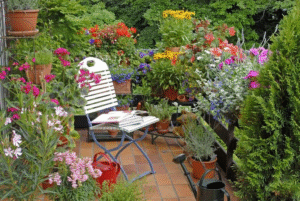Growing Green: Cultivating Your Own Produce, From Balcony to Backyard
In an era where sustainability and mindful living are gaining increasing prominence, home gardening has transcended its traditional image to become a vibrant movement. The allure of fresh, organic produce, coupled with the therapeutic benefits of nurturing plants, is drawing individuals from all walks of life, regardless of the size of their living spaces. From bustling urban apartments with compact balconies to suburban homes with modest backyards, the dream of growing one’s own food is entirely achievable with a little planning, creativity, and dedication.

The Allure of Homegrown Goodness
The appeal of home gardening extends far beyond merely saving money on groceries. There’s an undeniable satisfaction in harvesting produce that you’ve personally nurtured, free from pesticides and harmful chemicals. The taste and freshness of homegrown vegetables and herbs are unparalleled, often far surpassing anything found in a supermarket. Beyond the culinary delights, gardening offers a powerful antidote to the stresses of modern life. The act of tending to plants, feeling the soil, and witnessing growth provides a tangible connection to nature, fostering a sense of accomplishment and peace. Studies have shown that gardening can reduce stress, improve mood, and even boost heart health through light physical activity. It’s a holistic practice that nourishes both the body and the mind, making it an invaluable addition to any lifestyle.
Maximizing Small Spaces: The Art of Balcony Gardening
For urban dwellers in cities like Jaipur, where expansive backyards are a luxury, balcony gardening offers an ingenious solution. The key to successful balcony gardening lies in maximizing vertical space and choosing appropriate plant varieties. Multi-tiered plant stands, hanging baskets, and railing planters are invaluable tools for utilizing every inch of available area. Vertical vegetable garden walls, crafted from materials like PVC pipes, can create channels for growing leafy greens such as spinach, methi, and coriander. Herbs like mint, basil, and ajwain thrive in smaller pots, while compact varieties of tomatoes (“Patio Princess”), chillies, and even dwarf eggplants can flourish in medium-sized containers.
Crucially, understanding your balcony’s sunlight exposure is paramount. South or east-facing balconies typically receive ample sunlight, ideal for sun-loving plants. For shaded balconies, options like lettuce, spinach, and many herbs can still thrive. Proper drainage is non-negotiable; all containers must have drainage holes to prevent waterlogging. Lightweight potting mix, rather than heavy garden soil, ensures better drainage and reduces the overall weight on your balcony. Strategic placement of heavier pots and wind-resistant plant varieties can also mitigate challenges posed by wind and weather, especially on higher floors.
Cultivating Abundance in Backyards: Beyond the Balcony
For those with a small backyard, the possibilities for homegrown produce expand, though efficient space utilization remains key. Raised garden beds are an excellent solution, offering superior soil control, improved drainage, and often higher yields compared to traditional in-ground gardens. These structures allow gardeners to create optimal growing environments for a variety of vegetables, root crops, and even small fruiting plants.
“Square foot gardening” is another highly effective method for small backyards. This technique involves dividing the growing area into compact 1-foot by 1-foot squares, allowing for an incredibly efficient cultivation of diverse crops. Within each square, specific numbers of plants are grown – for instance, one tomato plant, four bush beans, or nine spinach plants per square. Trellises and other vertical supports are essential for vining crops like cucumbers, beans, and bottle gourd, allowing them to grow upwards and save valuable ground space. When selecting plants for a backyard in Jaipur, considering the local climate is vital. Drought-tolerant and heat-loving vegetables such as okra (bhindi), green beans, radishes, and various gourds tend to thrive, alongside classic staples like tomatoes, chillies, and an array of herbs.
Nurturing Your Green Haven: Essential Practices
Regardless of space, a few fundamental practices underpin successful home gardening.
- Soil Preparation: Using a nutrient-rich potting mix or a balanced blend of compost, peat moss (or cocopeat), and vermiculite provides plants with the essential nutrients they need. Regular replenishment of compost is crucial for maintaining soil fertility.
- Watering Wisely: Consistent watering is vital, particularly for container plants which dry out faster. Early morning or late evening watering is generally recommended. Avoid overwatering, ensuring the topsoil is dry before the next watering session. Self-watering pots or simple drip irrigation can be invaluable for busy gardeners.
- Pest Management: Regularly inspecting plants for pests and employing natural remedies like neem oil spray or garlic-chilli concoctions can keep infestations at bay without resorting to harsh chemicals.
- Composting: An integral part of sustainable home gardening is composting kitchen waste and garden trimmings. Methods like vermicomposting, self-watering compost bins, or simple layered composting (alternating green and brown waste) are effective even in small spaces. Composting transforms organic waste into nutrient-rich humus, feeding your plants and reducing landfill burden.
- Seasonal Awareness: In a diverse climate like India’s, understanding seasonal planting guides (Kharif, Rabi, and Summer crops) is crucial for selecting plants that will thrive in specific periods.
Embarking on a home gardening journey, whether on a bustling Jaipur balcony or in a cozy backyard, is a rewarding endeavor. It offers a tangible connection to nature, promotes healthier eating habits, and provides a calming escape from daily routines. With a little foresight, the right techniques, and a dash of patience, anyone can transform their limited space into a vibrant, productive oasis, enjoying the incomparable satisfaction of growing their own green bounty.




















